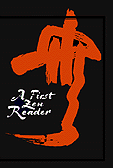 A FIRST ZEN READER
A FIRST ZEN READER
Extract
All Japanese know of the great painter Kano Tanyu, whose
work exists even today. This is the story of the time when he painted the
great dragon on the ceiling of the main hall at the temple. It was his
masterpiece and is one of the art treasures of the world. At that time, the
master of the temple at Myoshinji was the celebrated Gudo, famous as the
teacher of the Emperor. He had heard that the dragons painted by Tanyu were
so realistic that when a ceiling on which one had been painted fell down by
chance, some said it had been caused by the movement of the dragon's tail.
When the painting of the dragon at Myoshinji was mooted, Gudo went to the
painter's house and told him: 'For this special occasion I particularly want
to have the painting of the dragon done from life.'
Naturally the painter was taken aback, and saying: 'This is most unexpected.
As a matter of fact, I am ashamed to say that I have never seen a living
dragon,' would have refused the commission.
The Zen teacher, however, agreed that it would be unreasonable to expect a
painting of a living dragon from an artist who had never seen one, but told
him to try to have a look at one as soon as he could.
The painter asked wonderingly: 'Where can one see a living dragon? Where do
they dwell?'
'Oh, that's nothing. At my place there are any number. Come and see them and
paint one.'
Tanyu joyfully went with the teacher, and when they arrived, at once asked:
'Well, here I am to see the dragons. Where are they?'
The teacher, letting his gaze go round the room, replied: 'Plenty of them
here; can't you see them? What a pity!'
The painter felt overcome with regret, and in the event spent the next two
years with Gudo, practising Zen assiduously. One day something happened, and
he rushed excitedly to the teacher, saying:'By your grace I have today seen
the form of a live dragon!' 'Oh, have you? Good. But tell me, what did his
roar sound like?'
At this query, the painter was again at a loss, and for one further year
laboured on at his spiritual practices. What he painted at the end of the
year was the dragon of Myoshinji, a supreme masterpiece in the history of
art, remarkable for its technique but far more for the life which the artist
has infused into it. It seems as if it contains the great Life which
embraces heaven and earth, the universe and man also. It was to pierce
through to this reality that the master painter Tanyu poured out his heart's
blood.
To hear such a story is wonderful, but attainment is no easy thing...The
sutra says: 'Heroes become Buddhas with one thought, but the lazy people are
given the three collections of scriptures to traverse.

If the attention is put at the beginning of the stroke,
the stroke tails off into weakness.
If the attention is put at the end of the stroke,
the beginning becomes just a preliminary and shows weakness.
If we try to hold beginning and end together,
the middle of the stroke suffers.
If we try to move the mind with the brush,
the sense of unity is lost, and the stroke
gets out of proportion (here too big).
The Koan: How to make each bit of the stroke
with full attention and power,
and yet keep the unity and proportion
The koan riddle of the chinese character 'One'.
Synopsis
The main body of the book consists of two translations: A
Tongue-tip Taste of Zen, by Primate Takashina Rosen, who was the head of the
whole Soto sect in Japan, with its over 10,000 temples; Hakuin's Song of
Meditation, as commented on by Amakuki Sessan; these last were in fact a
series of broadcasts over the Kyoto Radio in 1936.
Contents
The Original Face by Daito Kokushi
A Tongue-tip Taste of Zen by Takashina Rosen, Primate of the Soto Sect
in Japan
Hakuin's 'Song of Meditation' commentary by Amakuki Sessan, of the
Rinzai Sect
The Two Poems by Oka Kyugaku
Bodhidharma and the Emperor from the Rinzai and Soto Koan anthologies
A Note On The Ways by Trevor Leggett
Review
One can easily imagine what a less great translator might
have made of much of this material: the lengthy disquisitions on technical
terms, the general nit-picking and colophon-grubbing. Instead, we have here
attractive, lucid prose that actually says something, than which nothing
could be more desirable in this field (of Zen).
Professor Roy Andrew Miller
 A FIRST ZEN READER
A FIRST ZEN READER
